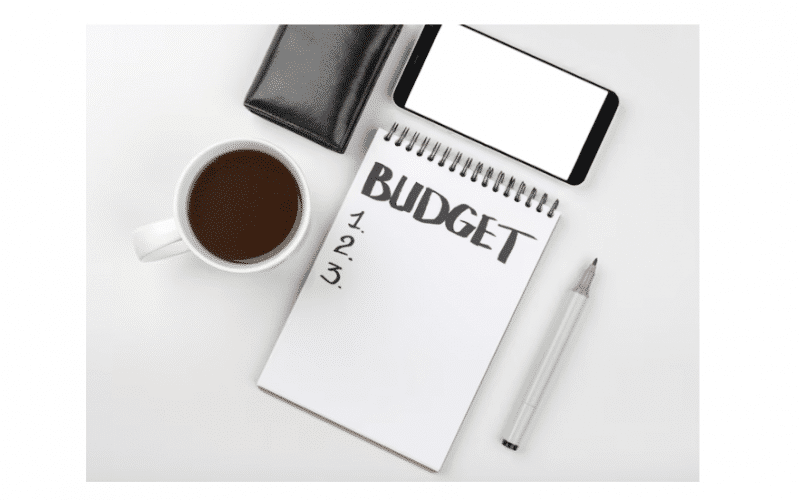A budget tracks and plans for both revenue and expenditure over a given period. Although budgets are used by both businesses and governments to keep track of revenues and expenses, you may be most familiar with them as a tool to manage your finances.
There are various kinds of budget systems and procedures. This article can help if you’re unsure of how to begin a budget and why it’s important.
What Is A Budget?
A budget is an estimate of income and expenses for a given time frame in the future that is typically created and reviewed regularly. Any entity looking to invest money, including businesses and governments, as well as individuals and households of any income level, can create a budget.
Budgeting is essential if you want to control your monthly spending, be ready for life’s unforeseen events, and be able to buy expensive products without going into debt. It doesn’t have to be tedious; you don’t have to be good at math, and keeping track of your income and expenses does not imply you can’t purchase what you want. Simply put, it means you’ll be more aware of where your money is going and in charge of your finances.
Note that:
- Governments, companies, and individuals of all income levels use budgets as an estimate of revenues and expenses over a given time.
- Budgets are essentially financial plans for a specific time, typically a year, and are known to significantly increase the progress of any financial endeavor.
- Corporate budgets are necessary for achieving maximum productivity.
- In addition to earmarking funds, a budget can help with goal-setting, outcome evaluation, and emergency planning.
- Personal budgets are very helpful for managing a person’s or family’s wealth over the long and short term.
What Are The 3 Categories Of Budgets?
The following three categories can be used to group budgets:
#1. Balanced Budget:
A balanced budget is one where expected government expenses match estimated receipts, promoting “living within one’s means.” This approach helps achieve economic balance and maintain discipline but does not guarantee financial stability, especially during times of deflation, recession, and economic depression. However, implementing such a balance can be challenging, as it requires balancing anticipated expenses and revenues.
#2. Surplus Budget:
A surplus budget is a government budget where revenue exceeds expenditure, indicating a country’s financial affluence. This type of budget is typically implemented during inflation to reduce aggregate demand and ensure the government’s gains from taxes exceed public welfare and development spending.
#3. Deficit Budget:
A deficit budget is a budget where the government’s expected expenses exceed revenue. It is suitable for developing economies like Brazil, especially during recessions, as it generates additional demand and boosts economic growth.
The government incurs excessive expenditures to improve employment rates, increasing demand for goods and services. This helps revive the economy by covering costs through public borrowings, such as issuing bonds or withdrawing funds from a reserved surplus.
What Is The Purpose Of Budget?
Making a budget is about taking charge of your finances, not depriving yourself. It shouldn’t be like a punishment. Note that it is a plan for all of your money, including money for recreational events or activities.
Additionally, a budget need not be strict. Therefore, it is supposed to change as your circumstances change, such as when you make more money from sales or have your wages increased. Your budget should be as unique as possible while still allowing for flexibility.
What Are The Types Of Budgets?
#1. Incremental budgeting:
Incremental budgeting refers to the method of using last year’s numbers to create the budget for the present year by adding and subtracting a percentage from them. It is suitable for budgets where the primary cost drivers remain constant. However, it can lead to inefficiencies, budgetary slack, and overlooking external factors like inflation in input costs.
Therefore, managers may overestimate the actual budget size, resulting in a team appearing under budget. Additionally, it may overlook external drivers of activity and performance, such as high inflation in input costs.
#2. Activity-based budgeting:
Activity-based budgeting is a top-down approach that determines the inputs needed to support a company’s output targets. For example, a company must identify the activities needed to meet sales targets and determine the costs associated with these activities.
#3. Value proposition budgeting:
Value proposition budgeting involves a budgeter considering the purpose of an item, its value for customers, staff, or other stakeholders, and whether its cost outweighs its value. Additionally, it aims to avoid unnecessary expenditures but is not as precise as zero-based budgeting. This mindset ensures that all budget items deliver value for the business.
#4. Zero-based budgeting:
Zero-based budgeting is a budgeting term that refers to budgeting that is started from scratch with zero funds at hand. Managers must justify every expense, avoiding unnecessary expenditures. This bottom-up approach is effective when cost containment is urgent, such as during financial restructuring or economic downturns.
Additionally, it is best suited for addressing discretionary costs rather than essential operating costs. However, it can be time-consuming, making it only used occasionally by companies.
How To Budget In 7 Steps
The particulars of your budget could well depend on your goals and individual financial situation. However, the procedures for making a budget are typically the same. Making a budget is as easy as following these seven steps.
#1. Add up all of your earnings.
All sources of income should be considered, such as salaries, tips, Social Security, disability benefits, alimony, and investment income.
#2. Maintain a spending log.
Keep a record of every dollar you spend for a month, regardless of whether you pay with cash or a credit card, to determine what your true out-of-pocket costs are. Include utilities, subscriptions, and automatic payments.
#3. Set monetary objectives.
Do you desire financial savings? repay debt? Stop spending too much. Identify achievable objectives. Keep in mind that you can change these over time. Therefore, make sure to decide what your urgent objectives are, such as establishing an emergency fund or repaying debts.
#4. Calculate the necessary outgoings.
These are bills that you have to pay regularly, like rent, insurance, taxes, child care, or your mobile phone bill. These are deducted from your overall income.
#5. List the due dates for debt.
Determine the bare minimum payment due on each debt if you are repaying debts such as student loan debt or a credit card bill. Also, deduct that from your income.
#6. Plan your spending.
You can spend your remaining income, depending on how much, on discretionary costs. These could be your objectives, like saving money or paying off debt. Additionally, it needs to account for things like unexpected costs for gas, entertainment, or groceries. Depending on your objectives and what you learned from tracking your spending, give each dollar a job.
#7. Make changes each month.
Examine your goals and spending each month, then reevaluate and change the allocation of your discretionary funds. You can prevent overspending if you have a flexible budget.
What Is The Main Objective Of A Budget?
A budget is a crucial tool for companies to provide structure and guidance on their direction, especially for those with rapid growth, seasonal sales, or irregular sales patterns. It helps predict cash flows and allocate resources effectively. However, it can be unreliable in the future, so it’s recommended to use a budget for the next few months to ensure a reasonable budgeting objective.
A budget can also be used to allocate resources, such as fixed asset purchases, but it should be combined with capacity constraint analysis to determine the most suitable allocation. Modeling scenarios can help estimate financial results, but it can be risky if management overly optimistically inputs assumptions.
Additionally, measuring performance is another common objective of creating a budget, but it can be treacherous as employees may modify the budget to achieve personal objectives, causing budgetary slack.
What Are The Three Main Purposes Of Budgeting?
The following three aspects of budgeting are included in the context of business management:
#1. Forecast of income and expenditure:
Budgeting is a crucial step in the process of planning a business. Managers and business owners must be able to forecast whether a company will turn a profit or not. Budgeting serves as a model of how the company might perform financially if such strategies, events, or plans are implemented.
Additionally, the supervisor attempts to project income and expenses, and subsequently profitability, when creating a business plan.
#2. Tool for decision-making:
The goal of budgeting is to give the decision-making process a financial framework, allowing us to determine whether or not the proposed course of action is something we have budgeted for.
Additionally, spending needs to be closely monitored to run a business responsibly. The answer to the question “Can we invest money in promotions?” is probably “no” once the promotion budget has been used up completely.
#3. Monitoring business performance:
Budgeting serves the purpose of allowing real business effectiveness to be compared to forecasted business performance, i.e., is the business meeting our expectations?
The “variance” in the figure to the left represents the discrepancy between planned and actual spending.
What Are The 4 Functions Of The Budgeting Process?
#1. Budgets allow for planning:
Planning is crucial for efficient business activities, starting with defining a company’s objectives and goals. Strategies are formulated, and tentative schedules are set up. A budget is a detailed schedule of the most profitable production factors for the upcoming period, providing specific deadlines and contributing to the organization’s overall objectives.
Additionally, budgeting influences strategies and shifts an organization from an informal, reactive style to a proactive management approach, focusing on positive measures and preventive actions.
#2. Budgets Improve Coordination:
Coordination is a managerial function that balances production and departmental activities to achieve an organization’s objectives. Budgeting promotes communication, understanding, and identifying organizational weaknesses. Additionally, it helps remove inconsistencies, reconcile differences, and ensure each department contributes to the overall objectives of the organization.
#3. Budgets improve communication within an organization:
An efficient organization requires everyone to be informed about objectives, policies, programs, and performances. Therefore, this is achieved through participation in the budgeting process, which informs managers of agreed-upon actions and resources available for achieving objectives and targets.
#4. Budgets Serve as a Framework for Control and Performance Assessment:
Budgeting involves departments analyzing their plans and submitting estimates for future spending. After approval, budgets become targets for setting spending limits. At the end of the budget period, a comparison of actual expenditures with budget expenditures is made to judge performance and assign responsibility for deviations.
Additionally, budgets serve as the basis for performance evaluation, allowing managers to monitor their performance and measure current performance more accurately than vague expectations or the previous year’s results.
What Is The Purpose Of A Budget In An Organization?
A budget enables a business to schedule expenses, realize objectives, and prepare for operational changes. However, without a budget, a company may overspend and perform poorly, which could eventually result in the Closure of the business.
What Is the Simple Definition of a Budget?
A budget is a financial plan that takes expenses and income into account. Additionally, it’s a projection of your income and expenses for a specific time frame, like a month or a year. For instance, if you’re keeping track of the money coming in and going out of your household as a whole, that’s a household or family budget.
What Is A Budget In Accounting?
A budget is a financial plan that projects future earnings and costs. A budget, put simply, plans future spending and saving in addition to anticipated income and expenses.
What Is A Budget Deficit?
A budget deficit happens when the government makes more expenditures than it makes in revenue. It is frequently used as a gauge of a nation’s financial stability. Instead of businesses or people, it is more frequently applied to government expenditures and receipts.
What Is A Budget Plan?
A budget plan takes into account the projected present and future income and expenses over a given period, typically one year. A budget plan ensures that your spending is under control and that your savings are progressing as planned.
What Is A Budget Analyst?
A budget analyst is a specialist who creates budget reports and keeps track of spending. Analysts of budgets assist both private and public organizations in planning their budgets. Additionally, they create budget reports and keep tabs on business expenses.
Related Articles:
BUDGET ANALYST SALARY: What Much They Make in 2023?
WHO IS A BUDGET ANALYST: Job Description, Duties & How to Become One
BUDGET RULES: What You Should Know






